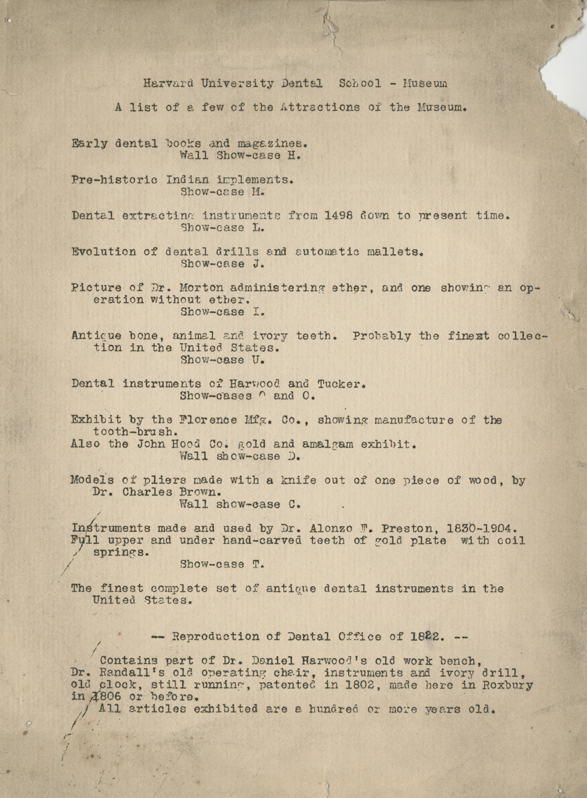Running Out of Room
Lack of space was an ongoing problem, and as early as 1925, Fernald reported,
In regard to floor space for a new Museum, in case we should ever obtain it, the school ought to have at least a space four times that of the present. Could we have a Museum of about 5000 feet of floor space, the larger the better, then as soon as the Museum could be equipped properly, many of our interesting specimens which are stored away could be exhibited. Then we would have a Museum second to none. The Museum could be made more educational should the students receive some lectures on dental history and art.
At the beginning of the 1930s, the Dental Museum still had strong support from the administration of the Dental School. Dean Miner inquired about the state of cataloging as "The Museum will be of increasing value as we develop the scientific aspects of dentistry in our curriculum, and I am anxious to have the cataloging at top efficiency."
The holdings of the Museum were also becoming known to an increasingly wider population. In August 1933, the American Dental Association met in conjunction with the Chicago Centennial Dental Congress, and one of the exhibits was the contents of the Museum's antique office—there was even a discussion of sending the mastodon tusk on loan—along with a phonographic recording of Dean Miner describing the contents for the public. Adelbert Fernald was sent with the exhibit as the opportunity was deemed "sufficiently good advertising to the School to warrant this expenditure." The Museum was likewise represented at the 1934 New York Dental Centennial, as part of an exhibit of historic and scientific dentistry. Along with a display of the antique office, items loaned from the Museum collection included over 100 hand-carved ivory dentures, the dentures of Oliver Wendell Holmes and Ralph Waldo Emerson, the Joshua Tucker gold filling, the set of decorated instruments of Thomas B. Hitchcock, and the turnkey and elevator of George Brewster. Fernald accompanied this loan also, though stated to the Dean, "Many of the specimens I do not understand why Dr. Weinberger selected, but presume he has some definite reasons. Personally if I could have made the selection I would have taken many specimens which would have been more interesting and from a visual standpoint, more educational, to illustrate the progress of the dental profession."
The harsh economic climate of the period, however, was beginning to have an effect, and Fernald reported to the Dean that he hoped to continue to enhance and improve his operations, but "I have spent hardly anything on the Museum for several years as I considered other departments needed the money more. Will you kindly let me know how much it would be wise for me to use for this purpose, considering the financial condition of the school?" One direct consequence, in the spring of 1932, was a reduction in the space allotted to the Museum due to the more pressing needs of the School's campaign to raise the endowment for a new building, and this provoked a critical outcry: "The inadequacy of the building is regrettably obvious … Its remarkable museum is forced into a crudely rearranged waiting room intended for clinic patients…."
A few weeks later, although the Administrative Board voted its thanks to Adelbert Fernald "for his interest in the Dental School Museum and for the progress that the Museum has made," Fernald was cautioned against continuing to acquire specimens when "so little space is available, and where funds are now at a premium." That fall, the Dean wrote to Fernald that the accumulation of gifts "is beginning to be a source of embarrassment so far as space is concerned." Finances were of even greater concern: "We have had to revise our budget, making great reductions in our estimates of expenditure, and we are trying to economize in every way possible."

